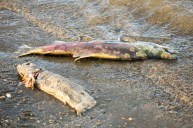When thinking of Antartica, most people imagine a barren and frozen landscape. After all, not many creatures can withstand the freezing temperatures. While scientists were already aware of the penguins, seals, and whales inhabiting Antarctica's southern hemisphere, they have recently discovered an entirely new ecosystem. Furthermore, they found it in a place they least expected — living under an Antarctic frozen lake.
Secret Ecosystem Living Under Antarctic Frozen Lake

Shutterstock Image
While researching the frozen Lake Enigma in Antarctica, scientists discovered more than they were anticipating. Rather than finding frigid waters barren of any life, they found a secret ecosystem teeming with life. Under the Antarctic frozen lake they found strange microbial communities, according to Live Science.
While scientists previously thought this lake was frozen solid, they recently discovered a layer of fresh water hidden beneath its frozen surface. Additionally, that layer of fresh water is "populated by a diverse cast of microorganisms." While scientists were surveying the lake, with "ground-penetrating radar", they detected "at least 40 feet of liquid water under the ice."
Although this was an incredible discovery all on its own, what they found next was even more exciting. After discovering the water, researchers began to drill into the ice and set up cameras beneath its depths. Then, they tested the water to find its origin.
What They Learned
After discovering the secret ecosystem living under the Antarctic frozen lake, researchers needed to know more. They concluded that the water in the lake is consistently replenished by the "nearby Amorphous Glacier." Researchers determined this based on the chemical composition of salts that they found in the water.
Furthermore, scientists discovered "several kinds of microbial life, which cover the bottom of the lake in blobs known as microbial mats." Many of these microbial mats differed, some appearing spiky while others resembled carpet. Additionally, many of these organisms are photosynthetic. Besides being a pleasant surprise for these researchers, it is also a huge step for science.
Before this discovery, "these organisms had never before been found in ice-covered lakes and don't normally thrive in high-oxygen conditions." Thus meaning that these microorganisms may have developed specific adaptations to survive in this environment. Definitely an exciting day for science.




